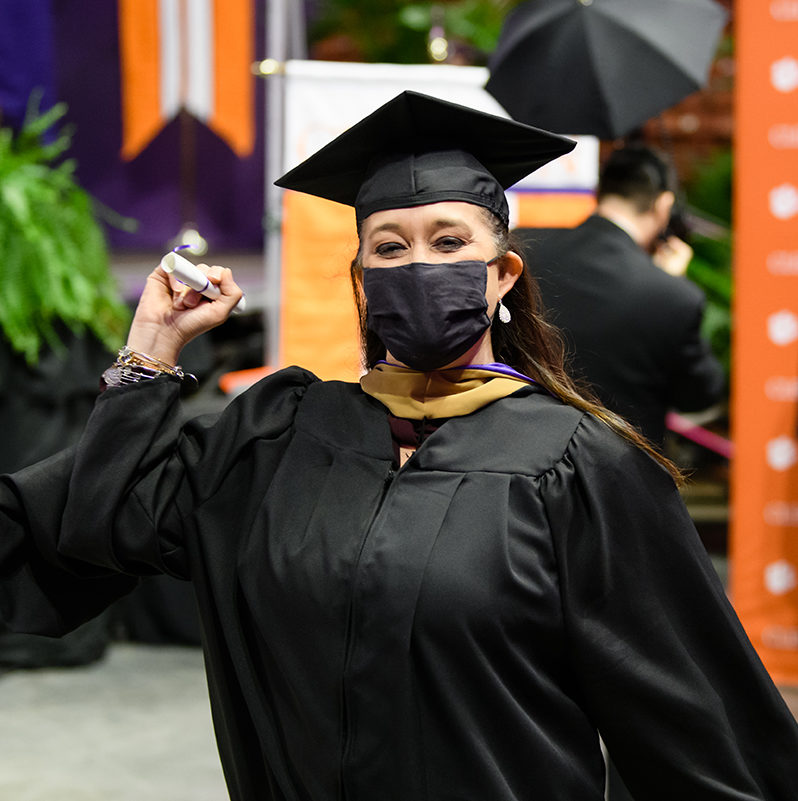CECAS work signals prosperity for South Carolina

In the classroom. Online. From the inner sanctum of sprawling research labs to the concrete floors of some of South Carolina’s most notable manufacturers: Clemson scientists and engineers have grown a notable body of work in cutting-edge engineering and science fields.
That work is being done by some of South Carolina’s best and brightest within the College of Engineering, Computing and Applied Sciences, men and women who have dedicated their life’s work to producing some truly transformative innovations — research and outcomes that have shaped not only researchers’ understanding but the world’s understanding of everything from energy and health innovation to advanced materials.
For CECAS students from undergraduate to Ph.D. level, that research and those outcomes look like good jobs in competitive fields.
For industry, it means access to a highly skilled workforce capable of growing South Carolina’s economy long into the future.
For senior materials science and engineering major Lauren Slann, the pursuit of her engineering program has prepared her for a lifetime of discovery. Slann is finishing up her third hands-on research opportunity in four years, and next year she will complete her bachelor-to-graduate degree program in materials science and engineering at Clemson, after which she plans to seek out a career focused on sustainability.
“It can be hard to transfer what you learn in the classroom into the real world,” says Slann, who comes from a long line of Tiger alumni, including Clemson professors and fellow family members who are past and current students. She grew up in Clemson, and her parents still live less than a mile from campus.
But it wasn’t family tradition that compelled the young engineer to pursue her Clemson degree. It was an intrigue in the environment and sustainability. Her degree program has a one-semester minimum research requirement, which she completed and then followed with a full year in the lab learning about ceramics and polymers. That was followed by an automotive research experience in nearby Greenville, which she finished up her senior year.
It helps show us the work we could be doing in the real world,” Slann says of the research requirements and opportunities. “This is the third lab I’ve worked in, and that experience has been everything for me.”
Her junior year, she interned with GE Aviation; she’s worked alongside graduate and Ph.D. students throughout her entire time at Clemson.
“Some schools and majors elsewhere I don’t think have as many opportunities for hands-on work,” she says. “Going straight out into the workforce having only been in a classroom isn’t a great idea, though. You don’t actually know what you’re capable of.”
The impact of top talent
Advanced materials research is the largest of Clemson’s research portfolios, with an average of $58 million in proposals submitted annually. Those dollars and the work tied to them do far more than simply expand outreach and grow knowledge in South Carolina. Advanced materials research inspires big, relevant innovations that bring about global change.
Just as the best employees seek the best workplaces, students like Slann are in search of programs aligned with cutting-edge scientific advancements, ongoing sustainability efforts and hands-on and postgraduate opportunities tied to work in those areas.

Clemson graduates more engineers and computer scientists than all four-year academic institutions in South Carolina combined.
With this leadership comes a tremendous sense of responsibility to meet the next generation of workforce needs that will foster economic development benefiting all South Carolinians.
Slann says the undergraduate materials science and engineering program is a perfect fit for her because she enjoys the blend of subject material, which combines chemistry with math, as well as the opportunity to work in the environmental aspects of materials science, with her eye on a career in sustainability.
The financial support she receives at Clemson has helped, as well. About half of the students in Slann’s major have a departmental scholarship; she receives tuition assistance in a variety of forms, including the Palmetto Fellows, Clemson Presidential, AVX Endowed, Kentwool and Charles A. Grant scholarships.
Likewise, top faculty look for institutions that offer research support and an interdisciplinary team of faculty and staff who are willing to build future industry partnerships that can continue to fund and ultimately employ their research.
Great people and great programs are important, but having great facilities to house them is the third, binding component of a great program. Top students and top faculty share a desire to work in the kind of world-class facilities that house leading talent and strong programs.
The next big step forward for CECAS and the University’s efforts to expand advanced materials research is the Advanced Materials Innovation Complex (AMIC), a new interdisciplinary research and teaching space to be housed on Clemson’s main campus. AMIC will be the new home for the Department of Materials Science and Engineering with strategic teams of advanced-materials-focused faculty from chemistry and chemical and biomolecular engineering. It will provide research facilities, educational laboratories and classrooms for multidisciplinary research and education, and it will be a home base for cross-disciplinary advanced materials innovation, education and research.
The footprint of the building will include 143,000 square feet of interdisciplinary research laboratory and teaching space to house a variety of classrooms, wet and dry laboratories, faculty and administrative offices, lecture halls, seminar rooms and shared innovation spaces. Greater collaboration among students, faculty, staff and industry partners in the science and engineering disciplines is designed to lead to greater innovation across South Carolina’s economy.
“This facility will be a focal point for education, research, partnerships and industry engagement,” said Anand Gramopadhye, dean of Clemson’s College of Engineering, Computing and Applied Sciences.
The project supports a statewide partnership through the Battelle Savannah River Alliance in connection with the Savannah River National Laboratory. Designed to support nearly 250 research faculty and personnel, the facility will cast a wide net for recruiting future talent and innovation. Undergraduate labs will accommodate more than 12,000 students a week, and the signature location and design of the facility will reinforce the University’s historical stewardship.
“A cutting-edge complex like this will strengthen Clemson’s service to the people of South Carolina, the nation and the world,” said Gramopadhye. “It will serve as an exemplar to recruit the most exceptional students and the most accomplished faculty and to accelerate increased grant funding and economic development with industry partners.”
When state-of-the art facilities, top-level talent and cutting-edge programs come together under great leadership, it attracts like-minded stakeholders and supporters. And that is where Clemson University’s College of Engineering, Computing and Applied Sciences now finds itself: assembling a broad cross section of industry stakeholders and legislative partners to be part of creating the next-generation solutions that will transform our nation and our world.
The post CECAS work signals prosperity for South Carolina appeared first on Clemson News.
Click Here for the Full Article
Author: Tara Romanella







